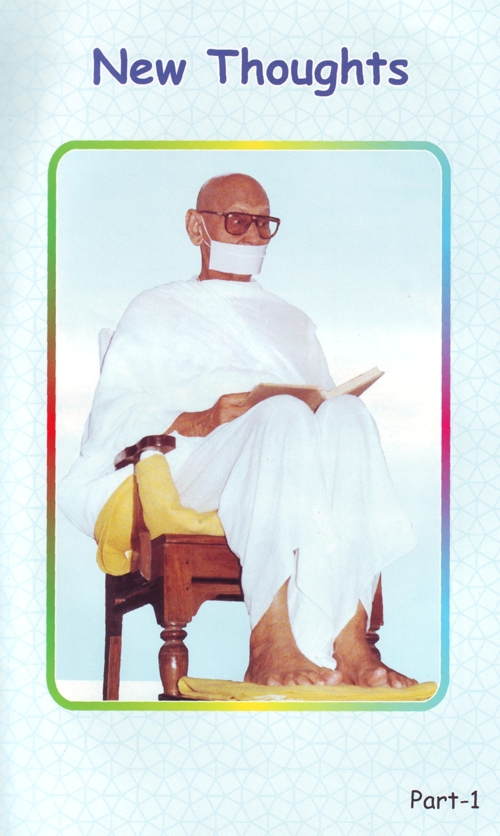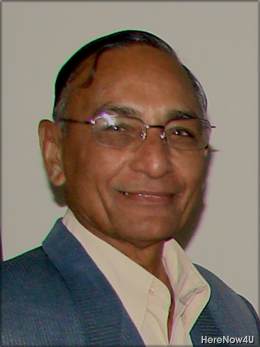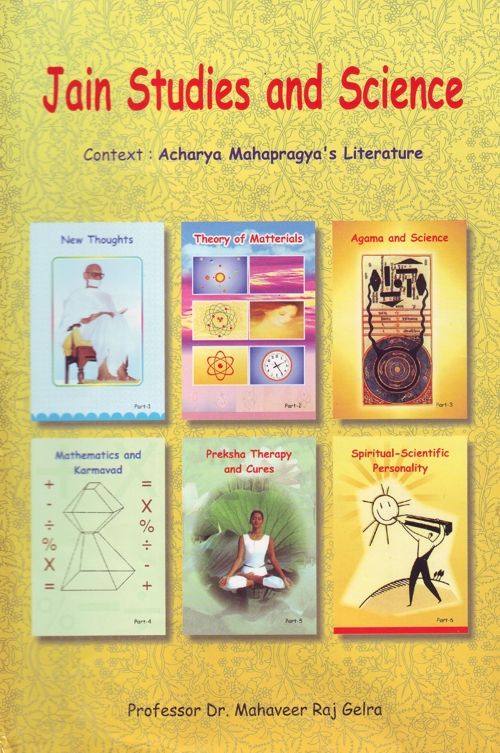
Mahapragya has successfully professed the Anekant viewpoint of Jainism. He pronounces that the whole is sum total of two opposites! This is an amazing statement on the part of Mahapragya, as he explains that opposites do not cancel each other, on the contrary they are complementary and add up to make a whole. A student of science knows thoroughly well that if there is matter, anti-matter is equally abundant. Opposites are actually two faces of the same coin, whose true and clear picture is complete only when both faces coexist together at the same place and the same point of time. For ease of understanding such pairs author prefers to term them as copposites.
Definition of Copposities
Mahapragya has stipulated a few postulates in order to expand his 'theory of opposites'-
- Copposites represent two mutually different directions.
- Existence of copposites is a self-proven Axiom. It is the very nature of every object to possess the copposites simultaneously.
- Copposites do not cancel each other but reinforce each other.
- There exists a definite co-ordination even in obvious conflict. Conversely, there exists conflict in apparent cases of harmony. This is the very basis of co-existent evolution.
Mahapragya has established the practical utility of above postulates which can be put to good use in resolving our every day conflicts of life. We shall present his thoughts concisely.
Universe
Each aspect of the entire universe is divided into two -
(i) Body and Soul
(ii) Macro and Micro
(iii) Tangible and Intangible
Humans are entrusted with the task of balancing these pairs. If we find too much of materialism, we shall have to invent spiritualism and vice-versa. Strangely, one is useless without the other. Imagine only Adam or only Eve at the beginning of life. One is not good enough, you need two, and that too, opposites! We can thus conclude that the creation, expansion and perpetuation of the entire Shrusti are possible due to the active presence of opposing pairs.
Democracy
Opposition is backbone of any democratic setup. Leftists keep rightists under reign. Now-a-days, however, the opposition acts more to pull down the ruling party, rather than strengthening it. A supporting and balancing role of opposition will create a healthy environment for the entire country. The basis of democracy is very much similar to that of Jain spiritualism, which stresses on the simultaneous presence of Dharmasti- and Adharmasti-kaya. It is also similar to the practical life, where accumulation and renunciation of wealth, both are equally important and necessary. It is, therefore, of all forms of governance, democracy is considered the most effective and stable way, because it is"based on the complementing structure of two opposites.
Destiny and Decisions
Modern society, by and large, follows two diagonally opposite doctrines-one section believes- 'Decisions and actions make destiny', while the other section believes 'Whatever happens is pre-destined'. Here, Mahapragya urges us to apply the law of opposites. The moment we accept the co-existence of positive-negative pair, the whole conflict collapses. It is a matter of common experience that howsoever hard one works; the results may not be commensurate with the efforts. Contrarily, if one sits idle and waits for destiny to act, void is what results! Decisions carve destiny and destiny moulds decisions.
Individual versus Society
It is aptly said that a man is a social animal. At times, the interests and preferences of an individual may conflict with those of the society, yet can the two be separated? Can the droplet survive beyond the ocean? Isn't the ocean made of droplets? But, ships cannot float on droplets and ocean cannot be carried in a container. An individual is as good as the society he lives in and vice-versa. An individual cannot take and sustain his growth in isolation. We have a case of reservations as example.
In India, a section of society grew allegedly at the cost of another. This called for the concept of reservation, as the decision makers were aware of the fact that the whole family of Indians must grow and become strong in order to survive globally. This resulted in conflict and friction. What if we see the whole situation differently from viewpoint of theory of opposites? We find a very simple answer to this vexed issue. If an individual, who receives the benefits of reservation, is ready to pay back to the society in the form of a simple promise - that his dependents and all the future generations will not further burden the society with perpetual benefits of reservation. This way, both the short-term and the long term interests of an individual and of the society can be met.
Mahapragya says that the co-operation and co-ordination is obvious in all the activities of universe. Creation-destruction, life-death, ephemeral-immortal, light-dark; they all co-exist, yet our minds have created the concept of conflict, which must be transformed to the theory of harmonizing and complementing the opposites.
Science and Spiritualism
Science is objective - always looking for cause and effect relationship. Philosophy is subjective - based on intangible experiences. As a pair, they become a fit case for applying the 'theory of complementing opposites'. Surprisingly, most scientific discoveries have philosophical origins. Similarly, science is giving new dimensions to the spiritual awakening. They need to be mutually reinforced further, rather than one discarding another. Today, science has concluded that if there is matter, there exists anti-matter too. They extrapolated the concept from atom/anti-atom, particle/anti-particle to universe/ anti-universe. How similar it sounds to the concepts of Dharmastikaya/ Adharmastikaya and Lok/Alok described in Jain literature!
Examples from Rishbhayan
Rishbhayan is one of the many verses penned down by Mahapragya. Sadhvi Shrutyasha has searched several instances which sound paradoxical at first, but contain the deep rooted message of coexistence of opposites. A few such mentions are -
- ' Waves in calm water'
- 'Marudeva's death made her immortal'
- 'As I approach nearer to the Almighty, HE maintains the same distance and illusion'
- 'Sun removed the darkness/but, it could not be seen in extreme brightness'
All these are imaginations of a poet, yet are very close to the truth. Mahapragya has extended his imagination up to the horizon where the practical reality meets the scientific theory. His logic is very simple, if a straight line can be made to bend, its two ends will eventually meet. According to him, the principle of Anekant gives us a tool with which the seemingly opposite ends can be bent to encircle the complete picture which depicts the whole truth.
Examples from Jain Literature
Term 'Pudgal' is extensively used in the Jain literature to describe the constitution of matter. Today, scientists use similar terminology for quarks and other micro particles. They have assigned various basic properties to these particles like frequency, spin, etc. Identical references are available in Jain literature regarding the basic properties of a 'Pudgal', which are, Varna (colour), Gandha (smell), Ras (taste) and Sparsha (touch). The last quality of Pudgals, namely, the Sparsha has further classification consisting of four opposite pairs - Snigdha-Ruksha (Degrees of smoothness), Light-Heavy (measurement of weight), Shiet-Ushna (Degrees of temperature) and Mrudu-Karkash (readiness to interact). In any composition of matter, presence of these opposite pairs is essential. Entire Universe is based on the co-existence of opposites.
The law of opposites as propounded by Mahapragya has its roots in the Jain Agams. Sthanang, Nandi and Dashvekalik Sutras have the description of opposite couplets aplenty. Some of them are mentioned forthwith -
- Mentions of pairing opposites are abundant in the first and second sections of Sthanang (Thagn) Sutras. Fourteen axioms are stated in the opening paragraph of the first chapter, out of these fifth to fourteenth are of special interest in the context of present discussions. These self sufficient truths are tabulated as follows-
5th - There is one LOK (Universe) 6th- There is one ALOK (Void) 7th - There is one Dharmastikaya (Dynon) 8th- There is one Adharmastikaya (Staton) 9th - There is one Band (Bondage) 10th- There is one Moksha (Emancipation) 11th - There is one Punya (Chastity) 12th - There is one Pap (Sin) 13th - There is one Ashrav (Attraction) 14th - There is one Samvar (Repulsion) Mahapragya comments that these axioms actually form pairs. The universe is fully filled with opposing pairs, or we may say that it is because of opposing pairs that the universe exists.
- The heading of first paragraph of second chapter of Sthanang (Thagn) Sutra is 'Dvipadavtar' - meaning 'duo'. It says everything under the sun appears in pair. A few such examples are - Jiva-Ajiva, Trus-Sthavar, Dharma-Adharma, Vedna-Nirjara etc.
- Similar pairs are mentioned in Nandi Sutra. Seven pairs of 'Shrut' are
described therein.
- In the Dashvekalik Sutra, four key human emotions - Anger, Ego, Affection and Greed are prominently discussed. Sutra states that these emotions co-exist with the contrasting feelings. Anger can be diluted by forgiveness and Ego with humility. Affection too, is a kind of bondage and can be countered by equanimity. Greed can be overcome by the feeling of contentment. Entire gist of these discussions is that the opposites coexist.
Mahapragya says that the Jains do not see things in black and white only. Their vision is not restricted to true-false but the third dimension of relative-truth is added to it. All thoughts and alternatives are just the diagonals of a circle - all equal and identical.
Examples from Medical ScienceEinstein has stated that the music cannot be truthfully described in scientific terms of frequencies and amplitudes only. It has an intrinsic value, above and beyond science, entering into the arena of higher consciousness. Human body is just like a symphony. It can be quantified in terms of medical parameters of blood, bones and muscles, yet it has an intangible and impenetrable spirit. A complete picture emerges only when 'the obvious' meets 'the occult'. Mahapragya has cited several examples from human anatomy where the two diagonally opposite forces exist and act in a coordinated manner.
- According to the medical science the body cohabitates two main centres of activities. One is- 'Gyan Centre' acted upon by Hypothalamus and another is 'Kama Centre' actuated by the Gonads. Pineal and Pituitary Glands when act on Gonads stimulate the acts of pleasure, while they act on hypothalamus to initiate the journey of super conscious knowledge. Ironically, these both activities are indispensable part of the human anatomy. Gyan is essential to protect the life while the Kama is inevitable to perpetuate the life. Both are interrelated and interdependent - reinforcing each other. It is difficult to establish the superiority of one over the other.
- Our body is abode to billions of cells. Every second, tens of millions of them die and an equal number of them born, thereby maintaining a perfect balance. Body is live only when both activities run simultaneously. An uncontrolled growth of cells results in cancer while the continuous decay of cells invites death.
- Psychologically too, the human behaviour is a mix of male-female qualities. Aggression and affection both coexist in all humans, albeit in different proportions. From Jain Karmavad view point, happiness-sorrow, auspicious-inauspicious, superior-inferior, longevity-fragility all types of conflicting karmas coexist. Their proportions vary from person to person, but their simultaneous presence is an undeniable fact.
Scientific investigations of micro world have so far revealed that the basic building blocks of the matter are quarks. Interestingly, these quarks are found in pairs of opposite spins. Even before this discovery, the co-existence of electron and proton, positively and negatively charged particles is a well established scientific fact. When Einstein described the properties of light, a startling fact was discovered that the light has dual nature of behaving as a particle and as a wave. Science could progress this far only after accepting the dualism of light. Properties of light have become central to the entire physics.
Properties of a magnet are very well known to us. Both north and south poles constitute a magnet. Even when broken into pieces, each piece keeps on exhibiting both poles in its magnetic force. Whatever we do, the two poles cannot be separated just as we cannot separate Siamese twins. If by some means, we are able to demagnetise a magnet, both poles disappear together. A magnet with single pole is impossibility.
Another excellent example from the field of physics is that of friction. One might think of an easy motion in the absence of friction, but the matter of fact is that the motion would have been impossible had there being no friction.
ConclusionLife and universe is nothing but a delicate balance of opposing forces, conflicting particles, contrasting energies and divergent view points. No adjective, no verb exists in this entire world, which does not have an antonym. Without the pairing opposite the world will loose its meaning. Light will be rendered redundant in the absence of darkness.
It is in our hands to convert conflict into complement. This is the main teaching of Jainism. Freedom should be responsibly controlled. Mankind must realise that male-female, hot-cold, light-dark, ephemeral-immortal, etc. all are inevitable realities. When they form the basis of our existence, we too, must live in harmony and compromise rather than conflict.
 Dr. Mahavir Raj Gelra
Dr. Mahavir Raj Gelra

